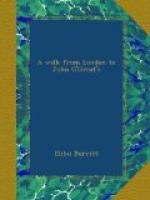It may possibly be true, that a few beautiful, fair-haired heretics in love or religion have been stone-masoned up alive in the walls of abbeys or convents. Sir Walter Scott leaned to that belief, and perhaps had credible history for it. But if the trowel has slain its thousands, the whitewash swab has slain its ten thousands of innocents. Think of the furlongs of richly-wrought tapestry, full of sacred and profane history, and the furlongs of curiously-carved panels, wainscoting, and cornice that floppy, sloppy, vandal brush of pigs’ bristles and pail of diluted lime have eclipsed and obliterated for ever, and not a retributive drop of the villainous mixture has fallen into the perpetrator’s eye to “make his foul intent seem horrible!” Think of Christian kings of glorious memory, even Defenders of the Faith, with their fair queens, princes of the blood, and knights, noble and brave, all, in one still St. Bartholomew night of that soft, thin, white flood, buried from the sight of the living as completely as the Roman sentinel at his post by the red gulf-stream of Vesuvius! Still, we must not be too hard on these seemingly barbarous transactions. “Not in anger, not in wrath,” nor in foolish fancy, was that dripping brush always lifted upon these works of art. Many a person of cultivated taste saw a time when he could say, almost with Sancho Panza, “blessings on the man who invented whitewash! It covers a tapestry, a carving, or a sculpture all over like a blanket;” like that one spoken of in Macbeth. England is just beginning to learn what treasures of art in old mansions, churches and cathedrals were saved to the present age by a timely application of that cheap and healthy fluid. For there was a time when stern men of iron will arose, who had no fear of Gothic architecture, French tapestry, or Italian sculpture before their eyes; who treated things that had awed or dazzled the world as “baubles” of vanity, to be put away, as King Josiah put away from his realm the graven images of his predecessors. And these men thought they were doing good service to religion by pushing their bayonets at the most delicate works of the needle, pencil and chisel; ripping and slitting the most elaborately wrought tapestry,- -stabbing off the fine leaf, and vine-work from carved cornices and wainscoting, and mutilating the marble lace-work of the sculptor in the old cathedrals. The only way to save these choice things was to make them suddenly take the white veil from the whitewasher’s brush. Thousands of them were thus preserved, and they are now being brought forth to the light again, after having been shut away from the eye of man for several centuries.




